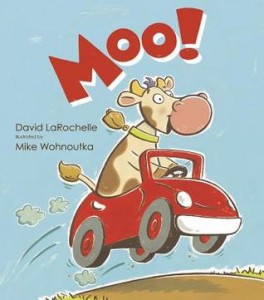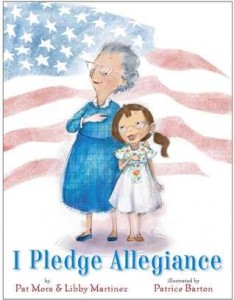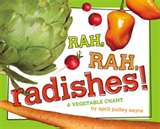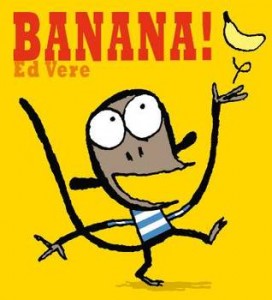Moo!
 It’s the beginning of a new school year and we want all our students to start off feeling successful. If you have kids that are beginning or struggling readers, here is a book that almost everyone will be able to read confidently: Moo! written by David LaRochelle and illustrated by Mike Wohnoutka.
It’s the beginning of a new school year and we want all our students to start off feeling successful. If you have kids that are beginning or struggling readers, here is a book that almost everyone will be able to read confidently: Moo! written by David LaRochelle and illustrated by Mike Wohnoutka.
This is no boring “baby book”. The humor of this one works for a wide range of kids, especially if you model reading it aloud with great expression. I read this one for an all-ages Stories in the Park event this summer and even the grown-ups were chuckling. Even though the book consists almost entirely of one word, the punctuation, the text formatting, and the pictures determine how the word is read. So not only is it a bull’s-eye for the Core Standard of Fluency, it works beautifully into a lesson on punctuation and Print Concepts.
Read Moo! aloud to your students and, once the giggles die down, talk about how you knew how to read the same word differently. For example, look at this page from the book:  There are moos in italics, in bold font, in all capitals and these differences, along with the punctuation, help determine how to read this page. Share the book again, asking different students to use the text and picture clues to help them read the page with feeling. Now you’ve got a lead-in to a great writing exercise. Brainstorm two lists: a list of punctuation and text styles that were used to change the meaning of “moo” so many times, and a list of animals that make a sound. Kids can write and draw about an animal that goes off on an adventure (using punctuation and formatting to show meaning) and they’ll only have to worry about spelling one word. Fun!
There are moos in italics, in bold font, in all capitals and these differences, along with the punctuation, help determine how to read this page. Share the book again, asking different students to use the text and picture clues to help them read the page with feeling. Now you’ve got a lead-in to a great writing exercise. Brainstorm two lists: a list of punctuation and text styles that were used to change the meaning of “moo” so many times, and a list of animals that make a sound. Kids can write and draw about an animal that goes off on an adventure (using punctuation and formatting to show meaning) and they’ll only have to worry about spelling one word. Fun!
I Pledge Allegiance
 Happy August! Although summer is in full swing in Michigan, one of my local elementary schools is already back in session. Whether your school bell has tolled or you have one more glorious month to enjoy, you’ll want to have this beautiful book in your classroom: I Pledge Allegiance by Pat Mora & Libby Martinez and illustrated by Patrice Barton.
Happy August! Although summer is in full swing in Michigan, one of my local elementary schools is already back in session. Whether your school bell has tolled or you have one more glorious month to enjoy, you’ll want to have this beautiful book in your classroom: I Pledge Allegiance by Pat Mora & Libby Martinez and illustrated by Patrice Barton.
Libby’s great-aunt Lobo is becoming a citizen of the United States. Her story gives a meaningful framework for the information shared about the Pledge of Allegiance. We learn a bit of history about the Pledge and what it means when we say things like “allegiance” and “indivisible”. The entire Pledge is in the text several times, so kids will be able to recite along. The soft art that celebrates our country’s diversity and the sprinkling of Spanish words (Libby’s great-aunt is from Mexico) are wonderful inclusions.
Not only is this book a fantastic story about the immigration experience, it’s the perfect springboard for a lesson on what we are really saying when we recite the Pledge of Allegiance. For example, Lobo tells Libby, “‘I like the words “liberty and justice for all… we are promising to be fair to everyone.'” Write the Pledge of Allegiance on a chart and put it next to a large open space on a whiteboard. Using I Pledge Allegiance as a guide, students can help translate the lines of the Pledge into terms that make sense to them. It’s a great vocabulary lesson (so you can check off Craft & Structure on your Common Core to-do list) and it will make the Pledge of Allegiance much more meaningful and personal for your students. This is patriotism at its best.
Read More
“Rah, Rah, Radishes” and Go, STEM!
 Happy May, everyone! I had the pleasure of speaking at an early education conference where our theme was literacy and science. I brought stacks of books that tie into STEM (Science, Technology, Engineering, Mathematics) or STEAM (add Art) to share. Rather than just lecture all day, I led a session of “speed-dating” books: we’d spend a few minutes skimming a book and brainstorming ways to use it with students, share our ideas with the group, and pass the book along. This way, we had time to get our hands on over a dozen books and walk away with practical classroom applications. I was so inspired by the fantastic ideas the teachers generated! Here are a few ideas we came up with after reading Rah,Rah, Radishes! A Vegetable Chant by April Pulley Sayre:
Happy May, everyone! I had the pleasure of speaking at an early education conference where our theme was literacy and science. I brought stacks of books that tie into STEM (Science, Technology, Engineering, Mathematics) or STEAM (add Art) to share. Rather than just lecture all day, I led a session of “speed-dating” books: we’d spend a few minutes skimming a book and brainstorming ways to use it with students, share our ideas with the group, and pass the book along. This way, we had time to get our hands on over a dozen books and walk away with practical classroom applications. I was so inspired by the fantastic ideas the teachers generated! Here are a few ideas we came up with after reading Rah,Rah, Radishes! A Vegetable Chant by April Pulley Sayre:
Bring in vegetables found in the book. Sort the vegetables by color and by size.
Classify and sort vegetables by the parts we eat: root vegetables, leaves, etc. Read Tops and Bottoms by Janet Stevens as a tie-in text and talk about which vegetables would be “tops” or “bottoms” according to Hare.
Predict which vegetables will sink or float. Test predictions in a tub of water. Wash the vegetables and talk about textures.
Use the vegetables to make prints.
Compare and contrast with fruits.
Weigh and measure the vegetables. Use a vegetable as a measuring tool.
Take photos of vegetables and label them. Reread the book and have students hold up the corresponding photos.
Make a chart or a Venn diagram with the terms “raw” and “cooked”. Try some vegetables both ways and chart our preferences.
See what other vegetables besides potatoes can be delicious mashed (great for little ones to do the mashing!)
Bring in potatoes with “eyes” sprouting and bring in vegetable seeds. Compare seeds and sprouts, then plant!
Make an edible collage with vegetables.
Practice patterning skills like ABAB, etc. with bite-size veggies and eat when done.
Plan a field trip to a farmer’s market or invite a farmer to come to the classroom for more vegetable experiences.
If you’re interested in the list of science books I shared, please email me at kristenremenar AT gmail DOT com. If you like Rah, Rah, Radishes! A Vegetable Chant, be sure to check out Go, Go, Grapes! A Fruit Chant and Let’s Go Nuts! Seeds We Eat also by April Pulley Sayre. Hooray for early science!
Read MoreBananas for Early Readers!
 Happy April, everyone! A teacher-friend asked me for super-simple books for readers who are wrestling with her lowest-leveled texts. I shared BANANA! by Ed Vere and the kids went ape. The facial expressions on the two monkeys are so engaging, and the text is limited to two words: “banana” and “please” with either question marks or exclamation points. As I read, I pointed out how the exclamation mark and question mark change the way we read the words. (Print Concepts mini-lesson? Check!)
Happy April, everyone! A teacher-friend asked me for super-simple books for readers who are wrestling with her lowest-leveled texts. I shared BANANA! by Ed Vere and the kids went ape. The facial expressions on the two monkeys are so engaging, and the text is limited to two words: “banana” and “please” with either question marks or exclamation points. As I read, I pointed out how the exclamation mark and question mark change the way we read the words. (Print Concepts mini-lesson? Check!)
Banana! is perfect for readers’ theater. After reading the book to your students, split them into pairs. The kids can make their own monkey masks or hats or puppets. Give students time to practice their lines (nailing that Common Core State Standard of Fluency). Then, kids take turns performing for the class, reading their lines as you hold up the book and turn the pages.
You can make a silly spin-off book called “Apple!” Take photos of two teachers arguing over who gets to eat the apple and lay them out like Ed Vere’s pages. You can make lots of little class books like this if you have a digital camera – let your students be the stars of the book, arguing over and eventually sharing an orange, or a pencil, etc. Your students will go, well, bananas for this book!
I’ll be in Elizabeth, New Jersey this month to talk about the best books to teach preschool and kindergarden reading standards. Next month, I’m the keynote speaker for an early literacy conference in Michigan and I have two presentations to public librarians on Common Core State Standards. Please keep your fingers crossed for ice-storm-free travel days!
Read More







